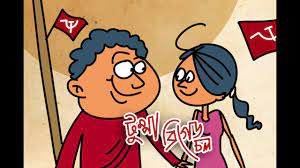“Tumpa” is a popular Bengali song, which was released in October 2020. This ‘dance number’ is the life of every household party and public festival in West Bengal.
There is something remarkable about “Tumpa” that transcends its popularity as a ‘dance number’. “Tumpa” perhaps signals an epic moment in the cultural history of Bengal with the upper echelons of the bhadralok seemingly ready — finally — to shed their self-projected cultural elitism and fully embrace popular, ‘glocalized’ Bengali cultural forms. It is significant because it pushes us towards some serious critical thinking about the remaking of bhadralok culture and, in turn, the remaking of the bhadralok itself.
It is interesting to note that the very idea of the bhadralok today is predominantly synonymous with that of an ‘artefact of the past’, a kind of a fossilized relic to be uncovered from the colonial archives. While the term referred primarily to the upper-caste, landowning class of Bengali Hindus in colonial India, the composition and the imagination of the bhadralok have undergone significant changes over the years. In 2004, Parimal Ghosh wrote an article in the Economic and Political Weekly titled “Where have all the ‘Bhadraloks’ gone?” — an insightful analysis of the changing profile and belief systems of the bhadralok in the post-Independence period that also had a subtle undertone of bemoaning the demise of the classical bhadralok. The post-Independence phase of the 1970s had produced the quintessential image of the jhola-carrying, radical, leftist bhadralok, articulate in political discourses, a lover of football as well as a connoisseur of ‘world art cinema’. This figure is peculiar: he speaks of Marxism and the emancipation of the working class but has a keen interest in keeping alive a strong division between ‘high’ and ‘low’; he professes secularism but has difficulty in pronouncing a Muslim name; he grieves the death of Maradona but continuously advises his son to focus on porashuno rather than on football. With the demise of Left politics in Bengal and the onset of ‘liberalization’, the bhadralok seems to be undergoing a complex process of metamorphosis that is difficult to capture in broad strokes.
“Tumpa”, in terms of content and genre, represents an apparent ‘subalternization’ of the Bengali cultural world. The lyrics, diction, pronunciation, attire and body language
of the lead actors and the singer represent a cultural world that is in absolute contrast to that of the imagined ideal of the refined bhadralok. The markers of this subaltern world are carefully chosen: poach-mamlet is a dinner-date delicacy; Digha is a potential honeymoon destination; nose-rubbing an expression of romantic love. This class identity is inscribed by the aspirations unleashed by a globalizing economy that is also constrained by the local limits of its realization. If one examines the lyrics of the song, it would resemble a parody of this subaltern world. It is a carefully and intelligently crafted composition packaged in a genre that has a popular appeal. Humour, a dominant element in the song, strives to make it inoffensive, rendering ‘harmless’ the objectification of ‘Tumpa’. It is this humour that creates a legitimate space to poke fun at the subaltern world.
The bhadralok has always been perceived as a status symbol. It will continue to survive on such a sense of distinction. The neat difference between high and low culture may
get muddled over time, but subtle distinctions may replace it while safeguarding the cultural and moral hegemony of the bhadralok. Even though some argue that we have arrived at a post-class society in which ‘class’ distinction in the traditional sense of the term seems to matter less, human society thrives on distinctions based on Othering and judgment. The term, bhadralok, may have become unfashionable, but bemoaning its death is perhaps premature because it will continue to thrive and exercise hegemony by reinventing newer ways of forging status distinction.










